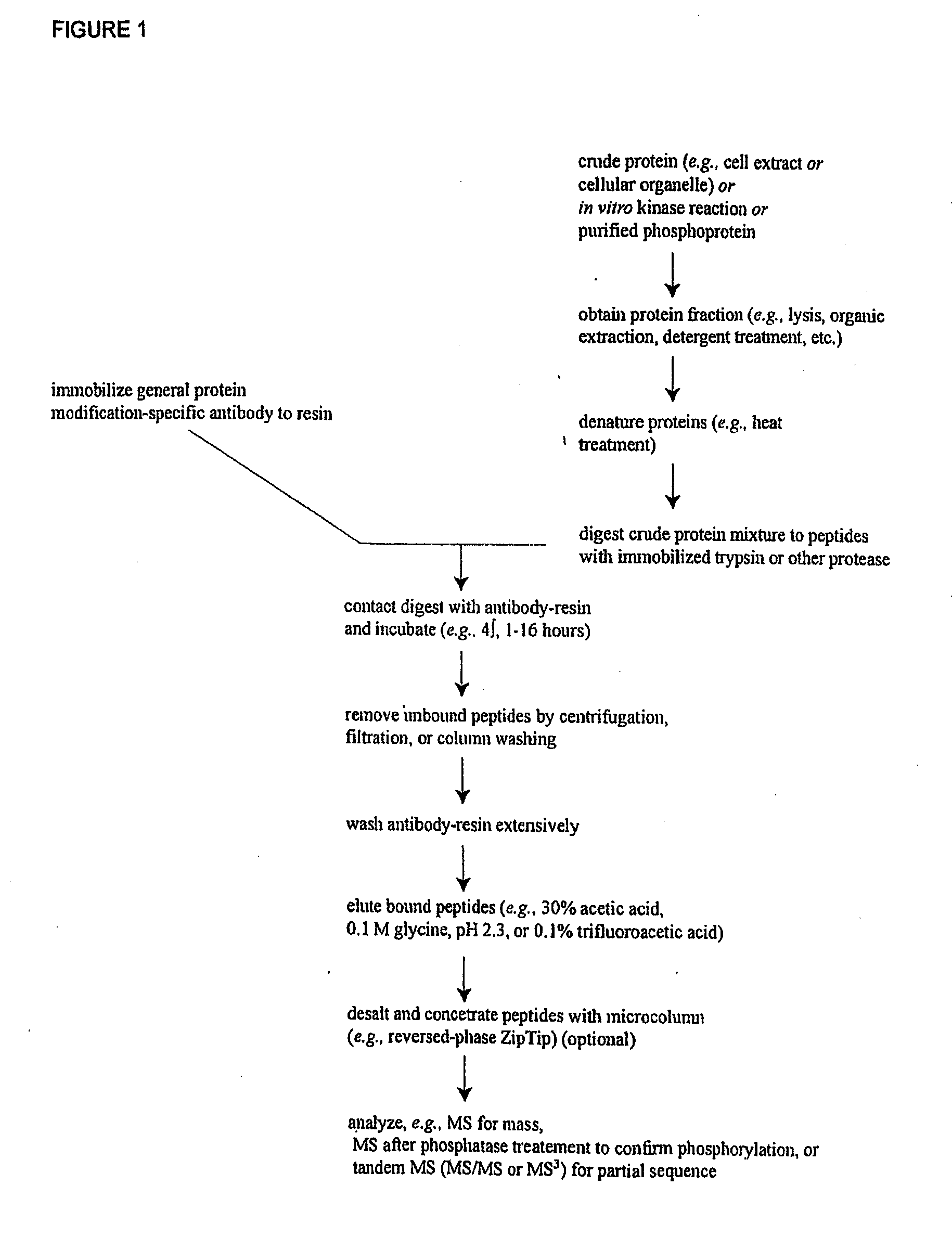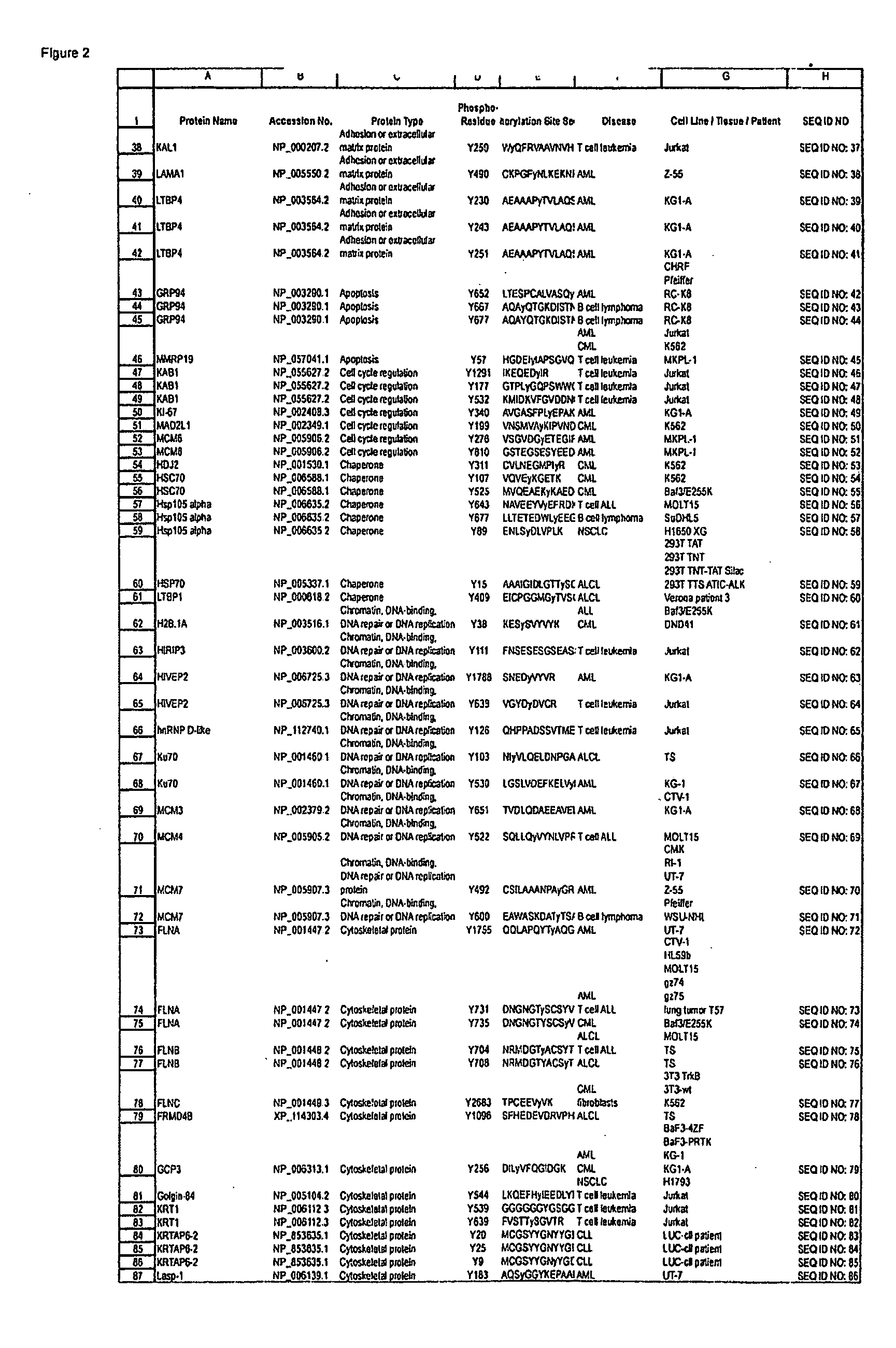Reagents for the detection of protein phosphorylation in signaling pathways
a signaling pathway and protein phosphorylation technology, applied in the field of protein phosphorylation detection in signaling pathways, can solve the problems of hampered complete and accurate understanding, inability to fully understand phosphorylation, and relatively scarce information about kinase-driven signaling pathways and phosphorylation sites relevant,
- Summary
- Abstract
- Description
- Claims
- Application Information
AI Technical Summary
Benefits of technology
Problems solved by technology
Method used
Image
Examples
example 1
Isolation of Phosphotyrosine-Containing Peptides from Extracts of Cancer Cell Lines and Identification of Novel Phosphorylation Sites
[0202]IAP isolation techniques were employed to identify phosphotyrosine containing peptides in cell extracts from the following human cancer cell lines, tissues and patient cell lines: 01364548-cll, 223-CLL, 293T, 3T3 TrkB, 3T3-Src, 3T3-TrkA, 3T3-wt, 577, A172, AML-4833, AML-6246, AML-6735, AML-7592, BaF3-10ZF, BaF3-4ZF, BaF3-APR, BaF3-FLT3(D842V), BaF3-FL,T3(D842Y), BaF3-FLT3(K663Q), BaF3-FLT3(WT), BaF3-FLT3 / 1TD, BaF3-PRTK, BaF3-TDII, BaF3-Te1 / FGFR3, Baf3, Baf3-V617F jak2, Baf3 / E255K, Baf3 / H396P, Baf3 / Jak2(IL-3 dep), Baf3 / M35 IT, Baf3 / T315I, Baf3 / TpoR, Baf3 / TpoR-Y98F, Baf3 / Tyk2, Baf3 / V617Fjak2 (IL-3), Baf3 / NY253F, Baf3 / cc-TpoR-IV, Baf3 / p210wt, CHRF, CI-1, CMK, CTV-1, DMS 53, DND41, DU-528, DU145, ELF-153, EOL-1, GDM-1, H1703, H1734, H1793, H1869, H1944, H1993, H2023, H226, H3255, H358, H520, H82, H838, HCC1428, HCC1435, HCC1806, HCC1937, HCC366, HCC8...
example 2
Production of Phospho-specific Polyclonal Antibodies for the Detection of Target Signal Protein / Polypepetide Phosphorylation
[0216]Polyclonal antibodies that specifically bind a target signal protein / polypepetide only when phosphorylated at the respective phosphorylation site disclosed herein (see Table 1 / FIG. 2) are produced according to standard methods by first constructing a synthetic peptide antigen comprising the phosphorylation site sequence and then immunizing an animal to raise antibodies against the antigen, as further described below. Production of exemplary polyclonal antibodies is provided below.
A. Grb10 (Tyrosine 404)
[0217]A 10 amino acid phospho-peptide antigen, YGMLLy*QNYR (where y*=phosphotyrosine) that corresponds to the sequence encompassing the tyrosine 404 phosphorylation site in human Grb10 adaptor / scaffold protein (see Row 11 of Table 1; SEQ ID NO: 10), plus cysteine on the C-terminal for coupling, is constructed according to standard synthesis techniques using...
example 3
Production of Phospho-specific Monoclonal Antibodies for the Detection of Target Signal Protein / Polypepetide Phosphorylation
[0224]Monoclonal antibodies that specifically bind a target signal protein / polypepetide only when phosphorylated at the respective phosphorylation site disclosed herein (see Table 1 / FIG. 2) are produced according to standard methods by first constructing a synthetic peptide antigen comprising the phosphorylation site sequence and then immunizing an animal to raise antibodies against the antigen, and harvesting spleen cells from such animals to produce fusion hybridomas, as further described below. Production of exemplary monoclonal antibodies is provided below.
A. MAD2L1 (Tyrosine 199)
[0225]A 13 amino acid phospho-peptide antigen, VNSMVAy*KIPVND (where y*=phosphotyrosine) that corresponds to the sequence encompassing the tyrosine 199 phosphorylation site in human MAD2L1 cell cycle regulation protein (see Row 51 of Table 1 (SEQ ID NO: 50)), plus cysteine on the C...
PUM
| Property | Measurement | Unit |
|---|---|---|
| concentration | aaaaa | aaaaa |
| pH | aaaaa | aaaaa |
| pH | aaaaa | aaaaa |
Abstract
Description
Claims
Application Information
 Login to View More
Login to View More - R&D
- Intellectual Property
- Life Sciences
- Materials
- Tech Scout
- Unparalleled Data Quality
- Higher Quality Content
- 60% Fewer Hallucinations
Browse by: Latest US Patents, China's latest patents, Technical Efficacy Thesaurus, Application Domain, Technology Topic, Popular Technical Reports.
© 2025 PatSnap. All rights reserved.Legal|Privacy policy|Modern Slavery Act Transparency Statement|Sitemap|About US| Contact US: help@patsnap.com



